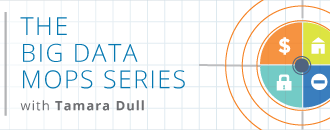Lessons in Quality, Reliability, and Risk
Originally published on Hub Designs Magazine May 2012
Lessons in Quality, Reliability, and Risk
Originally published on Hub Designs Magazine May 2012
“Lean” and “Agile” concepts have infiltrated aspects of many different kinds of businesses, from managing manufacturing processes to developing software. While there are several principles that define Lean processes, one of the most important ones is to provide more value more quickly to customers (both internal and external). There now seems to be interest in applying Lean and Agile to data governance, including very specific applications for data integration, MDM and data quality.
One of the difficulties for discussions of Lean/Agile concepts is that different constituencies in different industries and professional roles can have disparate definitions for Lean and Agile. Also important to remember: Lean and Agile have resulted in varying results, some good and some not-so-good. The following list covers what many who advocate for Lean consider the core principles (but many variations – and debates – exist):
The five-step thought process for guiding the implementation of lean techniques is easy to remember, but not always easy to achieve:
1. Specify value from the standpoint of the end customer by product family.
2. Identify all the steps in the value stream for each product family, eliminating whenever possible those steps that do not create value.
3. Make the value-creating steps occur in tight sequence so the product will flow smoothly toward the customer.
4. As flow is introduced, let customers pull value from the next upstream activity.
5. As value is specified, value streams are identified, wasted steps are removed, and flow and pull are introduced, begin the process again and continue it until a state of perfection is reached in which perfect value is created with no waste.
The fifth principle is the well-known concept of continuous improvement, which underscores initiatives for data governance and management, as well as data quality. If an enterprise is working on establishing an over-arching data strategy along with sensible processes and practices to enact the strategy, the enterprise needs concepts that will lead to very good results. Lean and Agile are tempting roads to travel, but will they take the enterprise to an optimal “destination”?
Lean Data Governance
The mantra of Lean management principles is often: Lean Is Not a Destination, It’s a Journey. The reality for data management and governance initiatives is that the work is never done simply because data-related processes must evolve as the business and its markets change and contort, and as data strategies mature and point the way for providing more value to business needs.
We know that data governance is a convergence of many areas that directly impact the relevance and usability of data in an organization: besides data-related practices and solutions, business process management and risk management are also part of the mix. Even more important are considerations for people and politics (or ‘culture’). Lean data governance must reflect all of these areas, or undesirable results can easily occur. Risk management, as a means to minimize risk levels for operational and other processes, has synergy with Lean principles through concepts such as eliminating “waste”, bringing more value to customers (internal and external), and engendering continuous improvement.
Lean Data Integration
Recently interest in lean data integration has increased as organizations seek faster means for integration processes, while still effective and comprehensive. Forrester lists “lean integration” as one of the Seven Top Integration Trends For 2011 To 2012. Paralleling the principles of Lean for manufacturing and adding Agile software development approaches, Forrester’s take on lean integration includes:
- Delivering quickly. Agile development techniques like Scrum (an iterative, incremental software development methodology) are a key component of Lean Integration, and this approach helps developers deliver results faster than using traditional techniques.
- Making continuous improvements. Integration tools support continuous improvement with features that enable easy modification, manipulation, and configuration of a wide range of application metadata artifacts, such as rules, policies, mappings, and processes. Speeding such change makes it easier and faster for developers to respond to the rapidly changing requirements typical of Agile processes.
Forrester expects many organizations to move aggressively to implement Lean Integration to speed up application delivery, especially those that value rapid delivery because it drives increased revenue and/or customer satisfaction (see Figure 4).
Source: Forrester, Seven Top Integration Trends For 2011 To 2012
The Quality Lesson from Toyota Lean — for Data Governance
For years, Toyota epitomized the promise of Lean manufacturing – after all, Toyota invented Lean Manufacturing. But Toyota painted itself into a corner when quality was compromised and dangerous part failures continued to plague the company for several years:
3.8 million cars recalled due to floor mats, of all things, getting caught up in the accelerator. What makes it so inexcusable is that it is not the first time.
“Toyota recalled 55,000 Camry and Lexus ES 350 models in 2007 because of complaints of unintended acceleration caused by the mats sticking under the accelerator pedal. The NHTSA said consumers continued to report instances of uncontrolled acceleration in Toyota models after that recall.”
So much for quality, and so much for continuous improvement and learning.
There is still debate whether Toyota Lean itself failed or if Toyota management failed to act wisely and failed to sustain Lean – likely all of the above contributed to very serious lapses in quality and value-generation at Toyota. Some want to argue that the problems trace back to design errors. But this situation is more complicated simply because of the history of technology enterprises in Japan and at Toyota: Business became Culture. Perhaps the most harmful action by Toyota was to lose sight of the principle of delivering value to the customer, a key component in Lean concepts, and a central business cultural construct.
So what do we learn from this Toyota story that matters for data governance? Quality cannot be sacrificed for efficiency when it comes to data in the enterprise; if the outcome of governance and management solutions is not reliable highly usable data, the solution efforts are useless, and potentially harmful. Lean also parallels the notions of “good enough” data quality and of context setting the rules to decide which data elements must be reliable – and both of these approaches have problematical aspects.
The Lean Iceberg Model was developed to help show the way to a more sustainable use of Lean principles. The idea is to understand the more overt artifacts of useful processes and continuous change — as well as the more subtle, but very significant, “hidden” artifacts that anchor, enable and sustain Lean processes. And the artifacts beneath the “water” are those of people, practices and politics / culture that are so important to organizational change. The parallels to data governance concepts are interesting and useful.
© 2008 P. Hines, P. Found, G. Griffiths, & R. Harrison
Source: “Staying Lean; Thriving, Not Just Surviving” – Peter Hines, Pauline Found, Gary Griffiths, Richard Harrison
Like Lean, Data Governance has to be more than technology and processes. Data governance must provide continuous improvement, and potentially faster data improvement results for the enterprise, through the never-ending interleaving of people, practices, processes and technology (and politics…). Healthy and constant collaboration across the enterprise to enable and empower vital data-related processes is a key element for beneficial outcomes and change. Hopefully the growth of cross-team collaboration will also engender faster and better decision-making related to enterprise data strategies.
Lean Has Some ‘Gotchas’
Going back to the principles of Lean listed at the beginning of this article, the fifth principle presents a potential misstep or flaw that has caused problems for corporations trying to implement Lean and Agile processes, no matter the purpose:
As value is specified, value streams are identified, wasted steps are removed, and flow and pull are introduced, begin the process again and continue it until a state of perfection is reached in which perfect value is created with no waste.
This fifth principle trips over a highly subjective, vague term: Perfection. Perfection is a chimera, never-attainable, and diverts attention from the realities of evolution, volatility, and change that impact most businesses. The realities of business environments, present and potential, must be recognized as part of the ongoing data governance journey. Organizations should strive for continuous improvement, but perfection is an impossible and useless goal. Competitive enterprises never sit still.
About the author: Julie Hunt is the Editor of Hub Designs Magazine. She is an accomplished software industry analyst, providing strategic market and competitive insights. Her 25+ years as a software professional range from the very technical side to customer-centric work in solutions consulting, sales and marketing. Julie shares her takes on the software industry via her blog Highly Competitive and on Twitter: @juliebhunt For more information: Julie Hunt Consulting – Strategic Product & Market Intelligence Services









